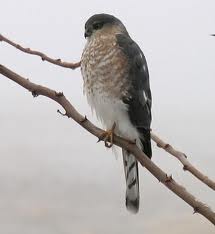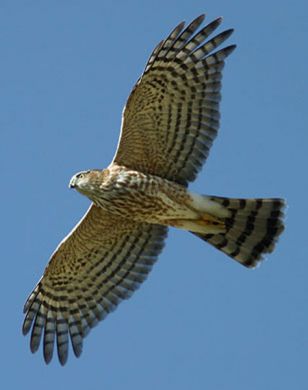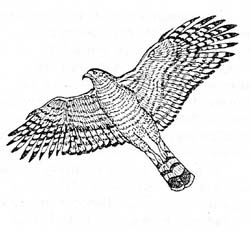Common Birds
Sharp-shinned Hawk
One of our winter visitors that arouse mixed emotions for those who feed birds is the Sharp-shinned Hawk, arriving in the Central Great Plains and Midwest from the North Country, usually by the end of October and departing by the first of May. This hawk has discovered that backyard bird feeders that attract winter birds can provided a sustainable food source. They often hunt birds attracted to bird feeders, but will only take what is necessary for their own survival.
by the end of October and departing by the first of May. This hawk has discovered that backyard bird feeders that attract winter birds can provided a sustainable food source. They often hunt birds attracted to bird feeders, but will only take what is necessary for their own survival.
Although it may appear that those of us who feed birds are providing a buffet for the Sharp-shinned Hawk, dinner doesn’t come easy. Birds at the feeders are constantly on alert for predators, and the more birds there are, the more eyes there are watching for hawks, cats, or any other dangers. Sharp-shins work diligently for a meal. More often than not, these little hawks seem to fly in and ambush ground feeding birds, such as doves, Juncos, and House Sparrows, who feed primarily on the ground and have less of a view than birds at elevated feeders. However, one squawk of warning from a Jay, or a sudden flush of birds, and all are headed for safety.
The Sharp-shinned Hawk (Accipiter striatus) is a small hawk. In fact, “sharp-shins”, or “Sharpies” as they are sometimes referred to by North American birdwatchers, are the smallest hawks to reside in North America. The species is widespread, occurring throughout a large part of the United States and Canada, except in the ice-covered regions of the far north. They inhabit in a wide range of woodland and forest habitats dominated by conifers and various types of broad-leaved trees, especially oaks. The largest populations of Sharp-shinned Hawks are thought to occur in the temperate boreal forests of Canada, but winter in warmer regions further south such as the central and southern United States, Mexico and Central America.
The males are 9.5 to 12 inches tall with a wingspan of 20 to 23 inches. They weigh approximately 3.5 ounces. The female Sharp-shins are distinctively larger as is common with most all birds of prey. She is 11.5 to 14.5 inches tall and has a wingspan of 23 to 27 inches. The female weighs an averages of 6 to 7 ounces.
Adults have short broad wings which allow them to follow their escaping prey into trees and heavy brush. They have a long square-ended tail which is banded in blackish and grey. The end of the tail is narrowly tipped with white. The underside of the wings and tail, only visible in flight, are barred whitish and blackish. They have yellowish legs and their hooked bill is black with a yellowish tip. The adult sharpie has a red eye, black cap, blue-grey back and upper wings with a white breast and belly marked with fine, thin, reddish bars. Immature birds have a yellow eye. Their cap, back, and upper wings are brown. The under parts of their body is extensively streaked with brown almost to the tail.
Sharp-shins surprise and capture all their prey from cover or while flying quickly through dense vegetation. In flight they typically use several quick snappy wing beats and a short glide, but they can also soar. They are very adept at navigating dense thickets. The majority of this hawk’s prey is small birds, especially various songbirds. Birds caught have ranged in size from a hummingbird to Sharp-tailed Grouse, and any bird within this size range is potential prey. Typically, males will target smaller birds while females will pursue larger prey. They often pluck the feathers off their prey on a post or other perch, or on the ground. Rarely Sharp-shinned Hawks will also eat rodents, lizards, frogs, snakes, and large insects.
Sharp-shinned Hawks will construct a stick nest in a large conifer or dense group of deciduous trees. The clutches range from 3 to 8 eggs, but are usually 4 to 5 eggs. The eggs are prized by egg-collectors, because they are heavily marked with surprisingly colorful and varied markings. The incubation period is thought to average at about 30 days. After hatching, the young are brooded for 16 to 23 days by the female, while the male defends the territory and catches food. The young fledge at about a month old and rely on their parents for feeding and protection for another 4 weeks. The nesting sites and breeding behavior of Sharp-shinned Hawks are generally secretive, in order to avoid the predation of larger raptors, such as the Goshawk and the Cooper’s Hawk.
Emotions are mixed when a Sharp-shinned Hawk catches a bird in one’s backyard. These little hawks hunt a variety of other habitats other than backyards, traveling on established routes throughout the day. If your feeders and yard become suddenly vacant of birds, that’s a good sign that a Sharp-shinned Hawk is in the area. If you happen to see a Sharp-shin in your yard, look at your watch. It will be there approximately the same time each day, especially if they have success in catching prey. Trees and bushes provide little safety for escaping birds since the short, rounded wings of the “Sharpie” allows them to maneuver quite effectively through such cover. Personally I am always awed at the opportunity to watch this predator-prey relationship that occasionally takes place outside my window. It is a natural occurrence that is part of the natural world we live in. 
Wingtips: Other raptors which hunt birds during the winter months and may be seen hunting near backyard bird feeders are the Cooper’s Hawk and American Kestrel, our smallest falcon. The Cooper’s Hawk is very similar to the Sharp-shinned Hawk in all plumages with the exception that the Cooper is much larger at 14 to 20 inches tall. They will capture medium sized birds using a low, stealthy approach-flight or after a short chase. They will use natural cover and even manmade structures to conceal their approach. In open areas the Cooper may drop on prey from high flight.
.jpg)
American Kestrels, our smallest falcon, hover to search out prey or will sit on a high perch. The male Kestrel has blue-gray wings and a lightly spotted chest and belly. The larger female has rufous wings barred with black, and streaking on the chest. They are about the same size as a male Sharp-shinned Hawk but have definite differences in their plumage. Although the Kestrel prefers to feed on large insects, rodents, and reptiles, they will also hunt birds, especially during the winter months.
